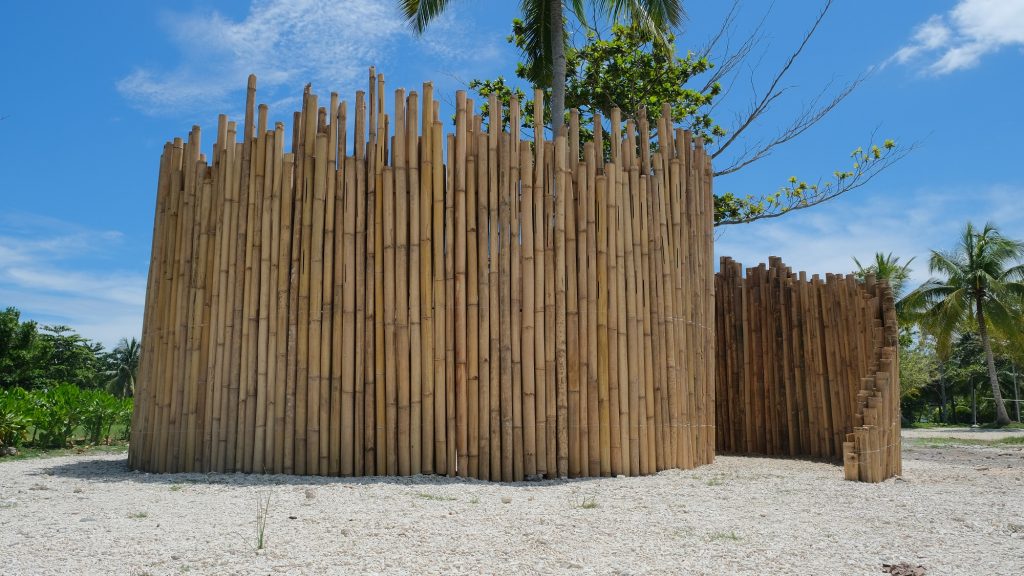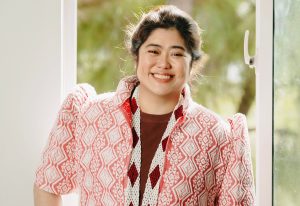
MANILA — Silverlens is pleased to announce the inauguration of the Lubi Art Project, a collection of environmental art installations created through the Lubi Art Residency, on June 7, 2025. The outdoor art installations, produced in collaboration with Torre Lorenzo Development Corporation, can be found at Dusit Thani Lubi Plantation Resort, Kopiat Island, Davao de Oro, Philippines. Launched last June 2023, Lubi Art Residency invited artists to create works by using, reusing, upcycling materials found on the island and its vicinity as core materials for their projects.
The inaugural artists for the Lubi Art Project 2025 are Poklong Anading, Isabel Aquilizan & Alfredo Aquilizan, James Clar, Corinne de San Jose, Gregory Halili, Wawi Navarroza, Bernardo Pacquing, Gary-Ross Pastrana, and Christina Quisumbing Ramilo.
The artists partnered with local community groups such as the Davao Gulf Divers and the Barangay Pindasan Women’s Group to create the installations. The resulting artworks will be both permanent and ephemeral, gradually deteriorating over time as nature reclaims its control.
ABOUT THE ART (SELECTED PIECES)
Created in 2018, Earth Mound by Bernardo Pacquing was the first outdoor art installation built on the island. Fascinated with the architecture of domes, Pacquing created Earth Mound from driftwood brought to the island by the sea. To experience the work over the seven years since its creation is to bear witness to its poetic decay, akin to the gradual unfolding of nature reclaiming control.
Inspired by Solfeggio Frequencies, Corinne de San Jose created 417, a sound installation made from locally-sourced bamboo. Each bamboo pole is tuned to 417hz which is believed to have healing and transformational effects on listeners. Walking the spiral path towards the center is a combination of a walking meditation and hunting blind – except there is no way to look beyond the bamboo walls, only upwards at the open sky.
“Every dive is a clean up dive,” – an ethos instilled in every diver – was how Poklong Anading found his material. Anading found abandoned fishnets in the photos he took while collecting plastic debris underwater. Galvanized by this discovery, a significant portion of his residency was dedicated to retrieving these nets with the Davao Gulf Divers. Inspired by the organic shape of the corals and the swirling motion underwater, recruit no. 3 is a promise and a space for regeneration.
ABOUT THE ARTISTS
Poklong Anading (b. 1975, Manila, Philippines; lives and works in Manila) works with a wide range of mediums and is acclaimed for his pieces that investigate photography and travel. Fascinated with the process of creation and permutation, Anading explores different mediums to engage with a range of sociopolitical and environmental questions. Having begun his career as a painter, he is not driven by an overt agenda, but prefers to let his mind wander, thinking with and through his materials as they undergo their transformations. He frequently uses found objects and discarded materials that lead him to investigate notions of worth and value, and to explore what it means for art to exist inside and beyond capitalist production.
Isabel Aquilizan and Alfredo Aquilizan (b. 1965 and 1962, Philippines) work in partnership as a couple, parents and artists. They migrated to Australia in 2006, but have recently moved back to the Philippines, where they work and reside in Los Baños, Laguna. Drawn from their experiences of being an immigrant family, their collaborations dwell on everyday life. Working across multiple mediums, from large-scale ephemeral cardboard installations to wall-bound metal sculptures, the Aquilizans provide space for people to gather and contemplate on themes of identity, home, migration, displacement, and belonging. In the
past few years, they have worked alongside artisans and craftsmen in Laguna to revitalize local cultural practice, a collaboration central to their artistic process.
James Clar (b. 1979, Wisconsin, USA; lives and works in Manila, Philippines) is a light and media artist whose work has been included in numerous exhibitions at museums and galleries worldwide, as well as being in various private and institutional collections. His work explores the conceptual and narrative potential of light and technology. These systems are integrated into our daily lives, altering the way we receive information and communicate. They inform our perception of reality, time, and space. Every system for communication enhances certain types of information while limiting and simplifying others. These modulated effects on our perception have become a thematic focus of his works and a way to experiment with narrative forms.
Corinne De San Jose (b. 1977, Bacolod, Philippines; lives and works in Manila, Philippines) is an interdisciplinary media artist based in the Philippines. Her works range from printmaking and video art to sculptures and sound installations, reflecting complex systems that interact
among these different forms. They deal with the different processes between materiality and the inherent performativity to explore other possibilities of perceiving her own environment within and around.
Gregory Halili (b. 1975, Manila, Philippines; lives and works in Manila) is an artist specializing in the intricate art of miniatures. He meticulously carves and paints mother-of-pearl shells, creating memento moris that capture contemporary concepts of memory, life, death, and cycles. Recently, he has broadened his practice to include miniature oil paintings. Transforming capiz shells into canvases, he delicately presses them to their most fragile state, nearly reaching the point of breaking. These thinned-down, glass-like pieces, featuring paintings of butterflies and moths on the reverse, offer a reflection on the intricate and fragile state of the environment and the future. After 25 years in the United States, he returned to the Philippines in 2013.
Wawi Navarroza (b. 1979, Manila, Philippines) is a Filipino contemporary artist known for her works in photography, actively exhibiting in galleries and museums in the Philippines and internationally. Her images explore Self and Surrounding as seen in her works in contemporary landscape, constructed tableaus, and self-portraits. Informed by tropicality within the dynamics of post-colonial dialogue, globalization, and the artist as transnational, her works transmute personal experience to the symbolic while probing materials and studio practice; all perhaps to mirror a path to understanding a deeper sense of place & identity.
Bernardo Pacquing continues to approach the expressive potential of abstraction in painting and sculpture through the use of disparate found objects that confront and disrupt perceptions of aesthetic representation, form, and value. By focusing on the organic shapes
of visual reality, his work displaces notions of indisputable forms and opens possibilities for coexisting affirmations and denials.
Gary-Ross Pastrana (b. 1977, Manila, Philippines; lives and works in Manila) is an artist deeply immersed in the philosophies surrounding concepts, objects, and art. His highly conceptual pieces, rich with poetic intensity, maintain an unobtrusive subtlety. Incorporating dynamic and nonsequential images along with other modes of study, such as music and science, his creations form a new textual narrative.
Christina Quisumbing Ramilo (b. 1961, Manila; lives and works in Manila, Philippines) examines and reimagines objects and surfaces through a sensitive approach to material and site specificity. Her artistic practice shows a profound interest in the life and history of objects and centers on interventions that reconfigure, transform, or give new life to existing forms. She renders known forms unfamiliar, making works that ultimately express and respond to personal poetries.

